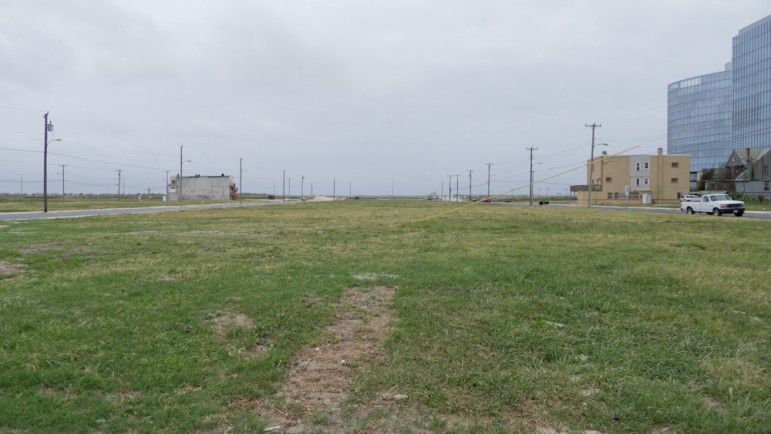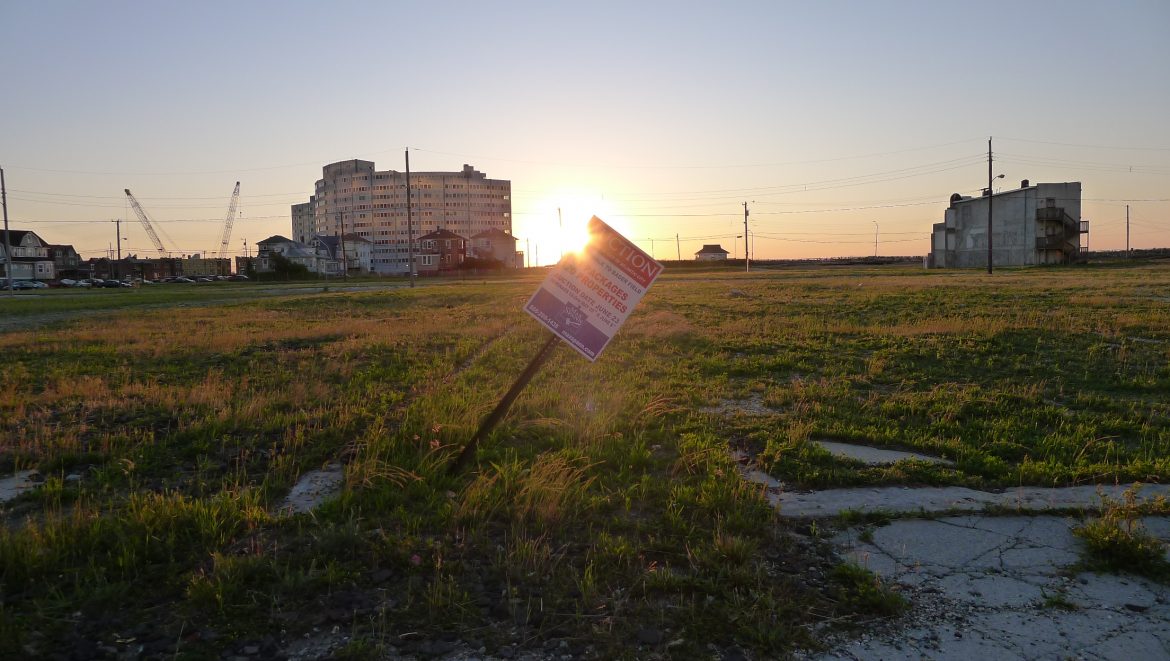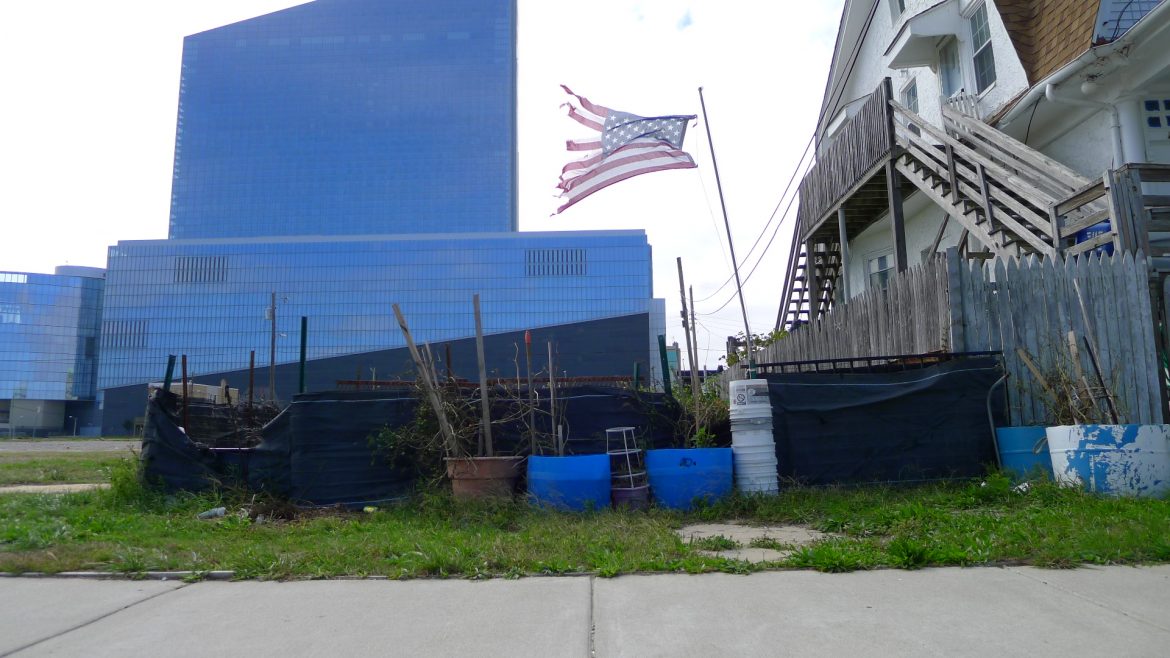This is an update of a story from a few weeks ago about developers seeking a variance to build a duplex–exciting!–on a vacant stretch of Atlantic City’s South Inlet that looks like it could have been airlifted from South Dakota and dropped onto the Jersey Shore.
When last we tuned in, that story’s protagonist–the developer Bruce Pender–was petitioning the Casino Reinvestment Development Authority for permission to not build a casino at 206 Vermont Avenue (the lot pictured above) because the land is zoned for “resort commercial development” and Pender does not wish to build a resort on this property. He only wants a two-family dwelling. To achieve this dream, Pender requires permission from CRDA because CRDA, for reasons that seem frankly a little less-than-democratic, has zoning authority over the South Inlet.
The state of New Jersey just yesterday initiated takeover proceedings against Atlantic City, but note for a second this informative photograph of the CRDA Board of Directors, which by my count shows the faces of fourteen white males and one white female. Yet it has zoning authority over large swaths of a city that’s 38% African-American, 30% Latino and 15% Asian. And probably made up of around 50% female persons (I’m just guessing). Maybe worries about a takeover are a little late.
Anyhow, since our last story, CRDA–or its Land Use Regulation and Enforcement Division–has seen fit to smile on Bruce Pender’s plans for a duplex and sent it up the chain of command for approval.
Given that this might be something of a watershed for this notoriously blighted neighborhood, some reflections:
HISTORY MATTERS!
The Pender Team began their pitch to the CRDA by showing aerial photographs from the Franklin Atlas taken in 1938 when the neighborhood was, “a thriving residential community on an absolutely beautiful beachfront/oceanfront portion of the City of Atlantic City,” in the words of planning engineer Jon Barnhart. “It existed that way for many, many years.”
This was still more or less the situation as late as 1965, a point made by Barnhart to no apparent objection by the Land Use Division. It is now the aforementioned disaster area.

“You know, as a planner and a person in land use development, every time I go down here, it just blows my mind that that — that that area is vacant, because it’s some of the most beautiful views in the state of New Jersey and probably the east coast,” Barnhart said.
THE URBAN LAND INSTITUTE’S ‘VISION’
Team Pender in their testimony cited a report by the Urban Land Institute that set forth a redevelopment “vision” for the South Inlet, calling for a “return to Atlantic City’s roots as members of a middle income diverse community who want to experience the ocean environment while entertaining themselves and their families.”
Historically, middle-income diverse residents have been regarded as a nuisance by certain observers of the Atlantic City Monopoly board, for instance Reese “Atlantic City needs a bulldozer six blocks wide” Palley.
More to the point, Barnhart’s musings on middle-income residents may have been received uncomfortably by CRDA officials (I’m guessing). The agency is, at this moment, seeking to remove Charlie Birnbaum’s property from the tax list by seizing it via eminent domain, despite a rather comprehensive rebuke from Superior Court Judge Julio Mendez, who called the called CRDA’s previous “condemnation” of the Birnbaum house, “a manifest abuse of the eminent domain power” that “exceeds the CRDA’s statutory condemnation authority.”
You can read Mendez’ August 5 ruling here. But he cites the “history of unsuccessful economic development projects in this area,” CRDA’s “lack of any specific and viable plans of the use of this property,” and the likelihood that it would remain vacant for years–like so much of CRDA’s other land around town–concluding, “our Legislature did not intend, and the Constitution does not permit, property to be acquired and to remain idle indefinitely, without a reasonable assurance that the proposed plan to justify the taking will be implemented.”
Nobody knows why CRDA likes vacant lots. We only know they do like them. They are challenging the Mendez ruling.
Anyway, the Birnbaum house is a one-minute walk around the corner from 206 Vermont Avenue (per Google Maps), but you could probably do it in about 15 seconds if you cut across the prairie.
Here’s what Chairman Lance Landgraf said, per the transcript, in response to the ULI “vision” comments: “The one statement I will make is that–and I–and I appreciate Jon referencing the ULI report. Just to note that that’s not–how do I put it? It’s not part of our master plan. It is a document that–that goes through a study that we did request of that area. So, it is–it is good reference. And I appreciate that–that being brought up. So… But, it’s not part of the master plan or the new regulations as of yet. So… But, it does promote exactly what is being–or offered today. All right. With that, we’ll close the testimony on this matter.”
‘I DON’T EVEN THINK YOU COULD REALLY GET A COMPLIANT DOGHOUSE ON THIS PROPERTY’
One last insightful takeaway from the minutes: The current zoning is so messy there’s no buildable footprint at 206 Vermont Avenue. I’m no engineer, but this seems amazing. The required “setbacks” for the property overlap, so there’s no building envelope on the property. Or as Christine Cofone, consultant to the board put it, “I don’t even think you could really get 17 a compliant doghouse on this property if you 18 apply the setbacks.”
So, why aren’t we talking about just rezoning the South Inlet?

